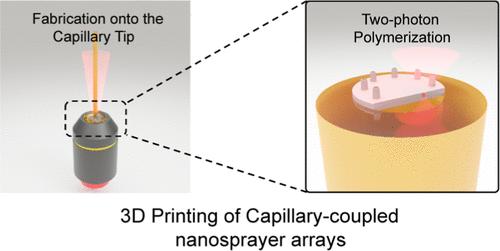毛细管耦合纳米喷雾阵列的双光子直接激光写入ESI-MS
IF 6.7
1区 化学
Q1 CHEMISTRY, ANALYTICAL
引用次数: 0
摘要
电喷雾是一种被广泛认可的物理过程,在静电纺丝、空间推进和质谱(MS)等领域有着广泛的应用。特别是,电喷雾发射器是不可或缺的电喷雾电离质谱(ESI-MS)的卓越性能。本研究介绍了一种利用双光子直接激光写入技术制造电喷雾发射器的新方法,从而将纳米喷雾阵列直接打印到毛细管尖端上。利用新型丙烯酸多面体低聚硅氧烷光刻胶,设计并打印了具有微米尺度通道的多喷嘴喷雾器,该喷雾器可用于前端液相色谱和典型的质谱入口。3d打印的喷雾器具有优异的耐有机腐蚀和高温性能。对于纳米喷雾器阵列,通过增加电喷雾的数量来增加总电喷雾电流,同时保持恒定的液体流速和电压。值得注意的是,与单喷嘴喷雾器相比,八喷嘴喷雾器的灵敏度提高了2.7倍。这种方法为ESI-MS提供了一种通用的高灵敏度纳米电喷雾解决方案。本文章由计算机程序翻译,如有差异,请以英文原文为准。

Two-Photon Direct Laser Writing of Capillary-Coupled Nanosprayer Arrays for ESI-MS
Electrospray is a widely recognized physical process and has various applications, such as in electrospinning, space propulsion, and mass spectrometry (MS). Particularly, electrospray emitters are integral to the exceptional performance of electrospray ionization mass spectrometry (ESI-MS). This study introduced a novel method for fabricating electrospray emitters using two-photon direct laser writing, resulting in the printing of nanosprayer arrays directly onto capillary tips. Utilizing a novel acrylic polyhedral oligomeric silsesquioxane photoresist, a multinozzle sprayer with micrometer scale channels was designed and printed on a capillary that is compatible with both frontend liquid chromatography and typical MS inlets. The 3D-printed sprayers demonstrated exceptional resistance to organic corrosion and high temperatures. For the nanosprayer arrays, an increase in the total electrospray current was achieved by augmenting the number of electrosprays, while maintaining a constant liquid flow rate and voltage. Notably, the eight-nozzle sprayers exhibited a 2.7-fold enhancement in sensitivity as compared with single-nozzle sprayers. This approach offers a versatile and high-sensitivity nanoelectrospray solution for ESI-MS.
求助全文
通过发布文献求助,成功后即可免费获取论文全文。
去求助
来源期刊

Analytical Chemistry
化学-分析化学
CiteScore
12.10
自引率
12.20%
发文量
1949
审稿时长
1.4 months
期刊介绍:
Analytical Chemistry, a peer-reviewed research journal, focuses on disseminating new and original knowledge across all branches of analytical chemistry. Fundamental articles may explore general principles of chemical measurement science and need not directly address existing or potential analytical methodology. They can be entirely theoretical or report experimental results. Contributions may cover various phases of analytical operations, including sampling, bioanalysis, electrochemistry, mass spectrometry, microscale and nanoscale systems, environmental analysis, separations, spectroscopy, chemical reactions and selectivity, instrumentation, imaging, surface analysis, and data processing. Papers discussing known analytical methods should present a significant, original application of the method, a notable improvement, or results on an important analyte.
 求助内容:
求助内容: 应助结果提醒方式:
应助结果提醒方式:


